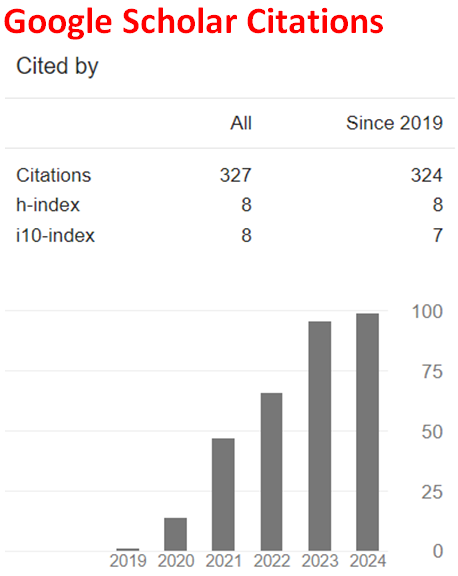Dicyanofuroxan and Its Charged Forms - A DFT Study
Abstract
Dicyanofuroxan is a new and interesting high explosive that can be used instead of some classical explosives. The present density functional treatment considers dicyanofuroxan and its ring opened dinitroso isomer. The treatment has been based on density functional theory at the level of UB3LYP/6-311++G(d,p). Within the constraints of the theory and the basis set employed the results indicated that the ring form of dicyanofuroxan is electronically more stable and thermodynamically more favored compared to its ring-opened dinitroso isomer. Transition state geometry and energy have been obtained for the ring opening reaction of dicyanofuroxan. Furthermore its charged forms are the focus of interest. Its monoanionic and dicationic forms decompose but mono cation form undergoes some bond elongations tending to decompose. Additionally some quantum chemical properties are presented and discussed.
Downloads
References
Fershtat, L.L., & Makhova, N.N. (2020). 1,2,5-Oxadiazole-based high-energy-density materials: Synthesis and performance. ChemPlusChem, 85, 13-42. https://doi.org/10.1002/cplu.201900542
Xiong, H., Yang, H., Lei, C., Yang, P., Hu, W., & Cheng, G. (2019). Combinations of furoxan and 1,2,4-oxadiazole for the generation of high performance energetic materials. Dalton Trans., 48, 14705-14711. https://doi.org/10.1039/C9DT02684C
He, C., Gao, H., Imler, G.H., Parrish, D.A., & Shreeve, J.M. (2018). Boosting energetic performance by trimerizing furoxan. J. Mater. Chem. A, 6, 9391-9396. https://doi.org/10.1039/C8TA02274G
Klapötke, T.M., & Witkowski, T.G. (2015). Nitrogen-rich energetic 1,2,5-oxadiazole-tetrazole-based energetic materials. Propellants Explos. Pyrotech., 40, 366-373. https://doi.org/10.1002/prep.201400294
Wu, B., Yang, H., Lin, Q., Wang, Z., Lu, C., & Cheng, G. (2015). New thermally stable energetic materials: synthesis and characterization of guanylhydrazone substituted furoxan energetic derivatives. New J. Chem., 39, 179-186. https://doi.org/10.1039/C4NJ01175A
Johnson, E.C., Sabatini, J.J., Chavez, D.E., Wells, L.A., Banning, J.E., Sausa, R.C., Byrd, E.F.C., & Orlicki, J.A. (2020). Bis(nitroxymethylisoxazolyl) furoxan: A promising standalone melt-castable explosive. ChemPlusChem, 85, 237-239. https://doi.org/10.1002/cplu.201900710
Stepanov, A.I., Dasko, D.V., & Astrat’ev, A.A. (2012). 3,4-Bis(40-nitrofurazan-30-yl)furoxan: A melt cast powerful explosive and a valuable building block in 1,2,5-oxadiazole chemistry. Cent. Eur. J. Energ. Mater., 9, 329-342.
He, C., Tang, Y., Mitchell, L.A., Parrish, D.A., & Shreeve, J.M. (2016). N-Oxides light up energetic performances: Synthesis and characterization of dinitraminobisfuroxans and their salts. J. Mater. Chem. A, 4, 8969-8973. https://doi.org/10.1039/C6TA03619H
Pepekin, V.I., Korsunskii, B.L., & Matyushin, Y.N. (2008). Explosive properties of furoxanes. Combust. Explos. Shock Waves, 44, 110-114. https://doi.org/10.1007/s10573-008-0015-z
Agrawal, J.P., & Hodgson, R.D. (2007). Organic chemistry of explosives. Chichester West Sussex: Wiley. https://doi.org/10.1002/9780470059364
Ledgard, J. (2007). The preparatory manual of explosives (3rd ed.). Jared Ledgard.
Homewood, R.H., Krukonis, W.J., & Loszewski, R.C. (1974). Safe explosive containing dicyano furoxane and method. US3,832,249.rese
Johnson, E.C., Bukowski, E.J., Sausa, R.C., & Sabatini, J.J. (2019). Safer and convenient synthesis of 3,4-dicyanofuroxan. Org. Process Res. Dev., 23, 1275-1279. https://doi.org/10.1021/acs.oprd.9b00186s
Gumanov, L.L., & Korsunskii, B.L. (1991). Thermal decomposition of dicyanofuroxane. Bulletin of the Academy of Sciences of the USSR, Division of Chemical Science, 40, 1702-1704. https://doi.org/10.1007/BF01172277
Larin, A.A., Bystrov, D.M., Fershtat, L.L., Konnov, A.A., Makhova, N.N., Monogarov, K.A., Meerov, D.B., Melnikov, I.N., Pivkina, A.N., Kiselev, V.G., & Muravyev, N.V. (2020). Nitro-, cyano-, and methylfuroxans, and their bis-derivatives: From green primary to melt-cast explosives. Molecules, 25, 5836. https://doi.org/10.3390/molecules25245836
Stewart, J.J.P. (1989). Optimization of parameters for semi empirical methods I. J. Comput. Chem., 10, 209-220. https://doi.org/10.1002/jcc.540100208
Stewart, J.J.P. (1989). Optimization of parameters for semi empirical methods II. J. Comput. Chem., 10, 221-264. https://doi.org/10.1002/jcc.540100209
Leach, A.R. (1997). Molecular modeling. Essex: Longman.
Kohn, W., & Sham, L.J. (1965). Self-consistent equations including exchange and correlation effects. Phys. Rev., 140, 1133-1138. https://doi.org/10.1103/PhysRev.140.A1133
Parr, R.G., & Yang, W. (1989). Density functional theory of atoms and molecules. London: Oxford University Press.
Becke, A.D. (1988). Density-functional exchange-energy approximation with correct asymptotic behavior. Phys. Rev. A, 38, 3098-3100. https://doi.org/10.1103/PhysRevA.38.3098
Vosko, S.H., Vilk, L., & Nusair, M. (1980). Accurate spin-dependent electron liquid correlation energies for local spin density calculations: a critical analysis. Can. J. Phys., 58, 1200-1211. https://doi.org/10.1139/p80-159
Lee, C., Yang, W., & Parr, R.G. (1988). Development of the Colle-Salvetti correlation energy formula into a functional of the electron density. Phys. Rev. B, 37, 785-789. https://doi.org/10.1103/PhysRevB.37.785
SPARTAN 06 (2006). Wavefunction, Inc. Irvine, CA, USA.
Matyas, R., & Pachman, J. (2013). Primary explosives. Heidelberg: Springer-Verlag. https://doi.org/10.1007/978-3-642-28436-6
Türker, L. (2011). Isomerization of 4,6-dinitrobenzofuroxan-A DFT study. J. Energetic Materials, 29, 127-149. https://doi.org/10.1080/07370652.2010.510496
Liu, Y-H., Wu, Y-H., Li, J-S., & Liu, M-H. (2020). Comparative modeling of improved synthesis of energetic dinitrobenzofuroxan (DNBF) derivatives. J. Mol. Model., 26, Article No. 240. https://doi.org/10.1007/s00894-020-04497-z
Naixing, W., Chen, B., & Ou, Y. (1994). Review on benzofuroxan system compounds. Propellants, Explosives, Pyrotechnics, 19(3), 145-148. https://doi.org/10.1002/prep.19940190306
Katritzky, A.R., & Gordeev, M.F. (1993). Heterocyclic rearrangements of benzofuroxans and related compounds. A review about the chemistry of benzofuroxans. Heterocycles, 35, 483-518. https://doi.org/10.3987/REV-92-SR2
Fleming, I. (1973). Frontier orbitals and organic reactions. London: Wiley. https://doi.org/10.1002/prac.19783200525
Anbu, V., Vijayalakshmi, K.A., Karunathan, R., Stephen, A.D., & Nidhin, P.V. (2019). Explosives properties of high energetic trinitrophenyl nitramide molecules: A DFT and AIM analysis. Arabian Journal of Chemistry, 12(5), 621-632. https://doi.org/10.1016/j.arabjc.2016.09.023
Badders, N.R., Wei, C., Aldeeb, A.A., Rogers, W.J., & Mannan, M.S. (2006). Predicting the impact sensitivities of polynitro compounds using quantum chemical descriptors. Journal of Energetic Materials, 24, 17-33. https://doi.org/10.1080/07370650500374326

This work is licensed under a Creative Commons Attribution 4.0 International License.


